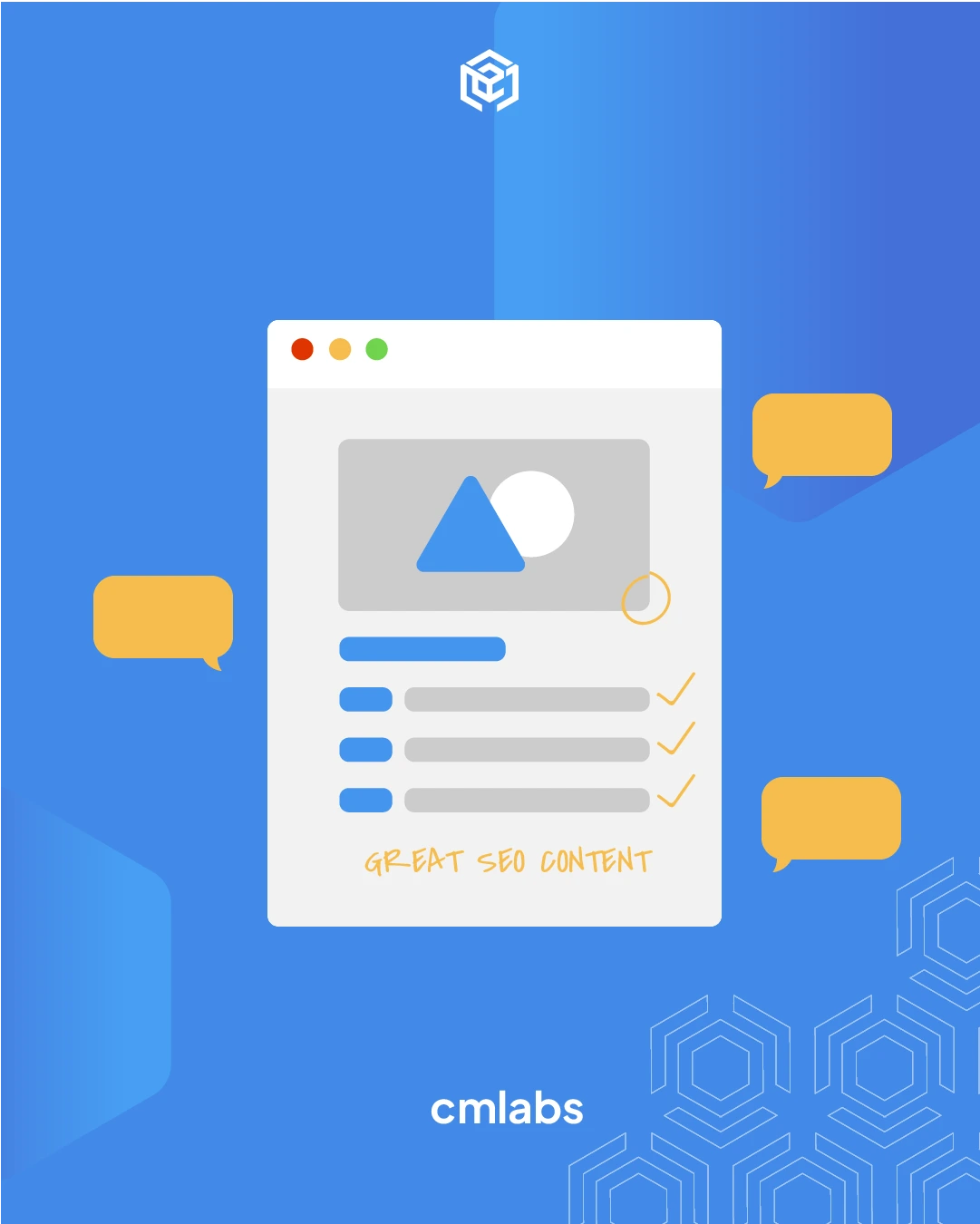We use cookies
This site uses cookies from cmlabs to deliver and enhance the quality of its services and to analyze traffic..
SEO SERVICES
Conduct in-depth technical website audits, strategically develop website projections, and increase your website authority.
ASO SERVICES
Elevate Your App’s Presence with Our Expert ASO Services – Boost Visibility and Drive Downloads!
WRITING SERVICES
We offer a variety of writing services to suit different business necessities. Reach broader audiences or lead specific industries? We've got you covered!
SEOlutions
A unified source of truth!
SEO & Digital Maternity Solution
SEO & Digital Maternity Solution: Leverage Cross-Platform Insights to Elevate Your Strategy with Expert Consultation
SEO & Digital Maternity Solution
Data Solution options:
Starting from Rp200 mio
Reinventing how a company get creative treatments
A new way to get your creative needs done. Agile team, efficient cost, and expedient way in a flexible yet scalable subscription plan!
Creative-as-a-Services
CaaS package options:
Based on Subscription
Pioneer in digital marketing software powerhouse
We’re excited to unveil our new range of Tech Solutions designed to drive your digital success. Whether you’re looking to enhance your website’s performance, streamline your tech stack, or unlock deeper insights from your data, we’ve got you covered.
Starting from Rp250 mio
Our Clients
Research and innovation center for digital transformation
Digital marketing combines technical skills and business knowledge at every stage. For marketing teams, improving budget management efficiency is crucial, as time is an invaluable resource that should be used wisely. At Sequence, we are dedicated to empowering you to optimize efficiency and strategic planning, ultimately enhancing the impact of your digital marketing efforts.
Subscription-based (IDR1,800/keyword)
Our Clients
BeyondSEO
References
SEO Tools for Webmasters
SEO Tools for Writers
SEO Tools
FIND THE SUITABLE PARTNERSHIP FOR YOUR COMPANY
Check out which cmlabs partnership program suits your company
WHITE LABEL SEO
for CorporateYour company is granted exclusive partnership rights to provide SEO services to our important clients, and we will provide a dedicated backend team to support your efforts.
AFFILIATE PROGRAM
for BizdevA new affiliate program is being introduced for skilled marketers and individuals with strong networks, offering commissions of up to 7% for generating profits independently.
DIGITAL AGENCY
for Marketing Partnerscmlabs is an essential partner for digital agencies, providing a unique selling proposition in Search Engine Optimization (SEO).
BACKLINK PARTNERSHIP
for Media / BloggerWe have a vast database of bloggers and media outlets across Indonesia, categorized by region and media type, giving our clients an edge in managing their media and SEO activities.
OFFICIAL TRAINING
We provide ongoing professional development and support to SEO professionals to ensure they are equipped to meet market demands.
JOIN AS CONTRIBUTOR
for Content WriterGreat opportunity for SEO Writers around the world. T&C applied!
ACADEMIC PARTNERSHIP
Through partnerships with universities in Indonesia, cmlabs has helped align academic curricula with industry demands.
Partnership
Sector & Industries
Tell us your SEO needs, our marketing team will help you find the best solution
As an alternative, you can schedule a conference call with our team
Schedule a Meeting?Contact
Survey
We use cookies
This site uses cookies from cmlabs to deliver and enhance the quality of its services and to analyze traffic..
Last updated: Jun 20, 2024
By using the rel attribute, you can establish relationships between the current document and other documents, which is useful in UX empowerment strategies and SEO optimization.
Let's discover what is rel in HTML and how to create page numbering with rel below.
Within the HTML code structure, there's the rel attribute, which is a component of the <a> tag or link to define the relationship between each page. 'rel' itself is an abbreviation of 'relationship'.
The rel attribute is also valid in <link>, <area>, and <form>, where the supported values depend on the element in which the attribute is found. However, some values might only be relevant in certain subsets of these elements.
So, what is rel in HTML? It is the attribute that specifies the relationship between the linked document and the current document. Search engines often use the rel attribute to gather more information about a link.
The rel attribute is only used when there's an href attribute within a structure. The href determines the location of the linked file or document, while the rel function in HTML is to mark the relationship between the linked document and the relevant document.
Then, you can use the appropriate rel attribute values for the type of relationship between pages. Here are the possible values of the rel attribute:
To write the rel attribute, you insert the rel attribute within the opening <a> tag as shown in the following example:
<a href="#" title="#" rel="#" target="_blank"><strong>#</strong></a>
Then, if there are multiple values for the rel attribute, you can write them separated by spaces or commas like this:
With spaces:
<a href="url" rel="noindex nofollow noopener ugc">text link</a>
With commas:
<a href="url" rel="ugc,nofollow,sponsored">text link</a>
Here is an example of using the rel attribute on the <link> element:
<link rel="stylesheet" href="/assets/css/dul-button.css">
The purpose of the rel attribute on the <link> element is to indicate that the linked file is a CSS file or stylesheet, while the href function indicates the location of that file.
You can use the rel attribute in browsers that support it, such as Chrome, Edge, Firefox, Safari, and Opera.
The rel attribute does not have a default value. So, if the attribute is removed or if there are no values in the supported attribute, then the document does not have any specific relationship with the target resource other than the hyperlink between them.
For example, if the rel attribute on <link> and <form> is missing, has no keywords, or has no one or more keywords separated by spaces above, then the element does not create any links.
On the other hand, <a> and <area> will still create links, but without the specified relationships.
Now that you understand what is rel in HTML, you also need to know how to use the rel attribute for page numbering.
As explained earlier, there are various values for the rel attribute in HTML, such as next and prev. These two values can be used to indicate the relationship between the URL components in a sequence with page numbering.
The sequence could be an article with multiple component pages, a product category with items spread across various pages, or a forum message sequence divided into sequential URLs.
Adding rel="next" and rel="prev" markup to the component pages in the sequence can inform search engines to combine indexing properties (like links) from the URLs or component pages into the sequence as a whole.
This means that links should not be scattered between page-1.html, page-2.html, and so on, but grouped according to the sequence.
Furthermore, rel="next" and rel="prev" markup also provide information to search engines to direct visitors to the most relevant URL.
However, it's important to note that there are some exceptions in the implementation of rel="next" and rel="prev".
If you want to offer a "view all" page to site visitors, you need to follow guidelines from search engines, such as Google, to understand how they display "view all" pages.
Search engines will display the "view all" page if it matches the search results rather than displaying component pages that tend to appear with rel="next" and rel="prev".
On the other hand, if you don't want search engines to display a "view all" page or if your site indeed doesn't have such a page, you can use rel="next" and rel="prev" markup as outlined in Google's official guidelines.
WDYT, you like my article?
Couldn't find result for "Mulki" try to search with different keyword
Suggestion:
Tell us your SEO needs, our marketing team will help you find the best solution
As an alternative, you can schedule a conference call with our team
Schedule a Meeting?



cmlabs Jakarta Jl. Pluit Kencana Raya No.63, Pluit, Penjaringan, Jakarta Utara, DKI Jakarta, 14450, Indonesia
(+62) 21-666-04470These strategic alliances allow us to offer our clients a wider range of SEO innovative solutions and exceptional service.

Psst! Hey there, SEO Stats and Tools SEO company! If you've ever planned of conquering the Philippines market, you've come to the right place!